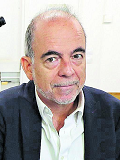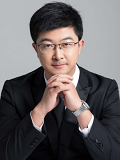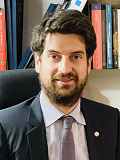Exosomes containing catalytic or hyperthermia-enabling nanoparticles: Novel tumor-targeting therapeutic vectors
Time
3:00 PM, June 27, 2025 (Beijing)9:00 AM, June 27, 2025 (Madrid)
Contact Us
Email: bmehjournal@sciexplor.comSpeaker

Prof. Jesús Santamaría
Department of Chemical and Environmental Engineering, University of Zaragoza, Zaragoza, Spain.
Jesús Santamaría, obtained his PhD in Chemical Engineering at Salford University in 1985, with postdoctoral stays at Notre Dame University (1989) and Massachussetts Institute of Technology (2008). Currently he is a Professor of Chemical Engineering and Exobiopharma Chair of Nanomedicine at the University of Zaragoza in Spain, as well as group leader at the Nanoscience and Materials Institute of Aragon (INMA) - one of the few research centers in Spain awarded with the highly prestigious Severo Ochoa label.
Prof. Santamaría is among the leading European researchers on the synthesis of nanomaterials and their application in fields from unconventional catalysis to nanomedicine. He has obtained numerous projects with European funding, including two of the highly prestigious ERC Advanced Grants (HECTOR, 2011-16 and CADENCE, 2017-23). He has published 385 peer reviewed manuscripts that have received over 22000 citations (h=76). His work has been acknowledged by numerous awards and other forms of recognition, including in recent years the Third Millennium "Research and Future" Award (2022), or his election as Academician in the Academia Europaea-The Academy of Europe (2022) and Istituto Lombardo Accademia di Science et Lettere (2023), and the Prize for Excelence in Research awarded by the government of Aragon (2024).
Hosts

Prof. Qihui Zhou
Laboratory of Biomaterials for Translational Medicine, University of Health and Rehabilitation Sciences, Qingdao, Shandong, China.
Qihui Zhou received his Ph.D. in Biomedical Engineering from the University of Groningen in 2018. Now, he is a high-level talent/professor/PI of the University of Health and Rehabilitation Sciences and the Head of the Institute of Biomaterials for Tissue Repair and Rehabilitation. He is also a Taishan Scholar and leader of the "Materiobiology" project of the "Youth Innovation Science and Technology Plan". The "acellular amniotic matrix for injection" developed for two indications of infraorbital depression and osteoarthritis has entered the stage of registered clinical trials. So far, he has published more than 90 papers as the first/corresponding author (35 papers with IF > 10), including Chemical Reviews (ESI highly cited, cover paper), Advanced Functional Materials (5x), Nature Communications, Science Advances, Advanced Science, Nano Energy (3x), etc. His research papers have been cited nearly 5,400 times with an H-index of 40 (Data from Google Scholar). He was invited to be an expert evaluator of the Netherlands Organization for Scientific Research (NOW-VIDI) and the National Science Center, Poland.

Prof. Filippo Rossi
Department of Chemistry, Materials and Chemical Engineering "Giulio Natta", Politecnico di Milano, Milan, Italy.
Filippo Rossi is an associate professor in Applied Physical Chemistry at the Department of Chemistry, Materials and Chemical Engineering "Giulio Natta" at Politecnico di Milano (Milano, Italy). He received Master Degree in Chemical Engineering (2007) and then Ph.D. in Industrial Chemistry & Chemical Engineering (2011) both from Politecnico di Milano. He also spent research periods abroad as visiting Ph.D. student at Imperial College London (2009), as Post-Doc at Uppsala University (2012) and as visiting professor at Keio University (2018, 2022), Tokyo University of Agriculture and Technology (2025) and University of North Carolina at Chapel Hill (2025). From 2015 he is also enrolled as guest researcher at Istituto di Ricerche Farmacologiche Mario Negri and since 2022 as visiting professor at University of Southern Switzerland. His main research interests are in the field of innovative polymeric materials for nanomedicine, drug delivery and tissue engineering with experimental and modelling studies.
Introduction
Cancer continues to be a major health issue. Current estimates indicate that by 2030 over 20 million new cases will be diagnosed yearly, and cancer will cause 13 million deaths worldwide. The economic burden is also staggering, estimated at over 25 trillion $ over the next three decades. The arrival of Nanomedicine was expected to change radically this scenario, and indeed hundreds of novel nanoparticles (NPs) with exciting antitumor properties have been reported, but cancer nanomedicine has not achieved clinical translation, largely due to a simple fact: less than 1% of the nanoparticles injected systemically reach the tumour.Extracellular vesicles (EVs) and in particular exosomes have emerged as powerful alternatives able to enhance tumour delivery of nanoparticles. EVs are membrane-surrounded vesicles of biological origin that play an essential role in cell-to-cell communication. Due to their selective delivery capabilities EVs have raised great expectations, being called a “next generation drug delivery platform”. The selectivity of EVs as vectors is based on homotypic recognition, with selective targeting determined by the pattern of proteins in the EVs membranes. Thus, hybrid vectors that combine the targeting properties of EVs and the therapeutic properties afforded by NPs are very attractive for cancer nanomedicine. The obvious problem to obtain EV-NP hybrids is to achieve a significant loading of NPs without impairing the desired membrane properties.
In this talk we will present some recent developments of our laboratory that create therapeutic exosomes by incorporating NPs capable of hyperthermia or of enabling catalytic therapies. Methods to load these particles without disrupting EVs membrane are discussed. Also, we will discuss the results of previous works of our laboratory in vitro and in vivo showing the potential of these EVs as new anticancer therapies.
Presentation
Presentation
175
Free Discussion
94



